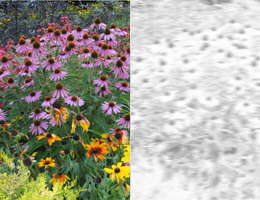Achromatopsia: New gene therapy tested in patients
 Patients with achromatopsia are completely color blind. Their vision is blurred and their eyes are highly sensitive to bright light. Image and simulation: Stylianos Michalakis
Patients with achromatopsia are completely color blind. Their vision is blurred and their eyes are highly sensitive to bright light. Image and simulation: Stylianos Michalakis
People who are born with complete color blindness are unable to distinguish colors. Their vision is blurred and their eyes are highly sensitive to bright light. This is due to a defect in the cone cells - the light receptors in the retina that are responsible for daylight and color vision. Complete color blindness, or achromatopsia, affects around 3,000 people in Germany. As yet, there is no treatment for the underlying cause.
In about one-third of all achromatopsia patients, the defect lies in the CNGA3 gene. A team from the Institute for Ophthalmic Research at the University Hospitals in Tübingen and the Departments of Pharmacy and Ophthalmology at LMU has developed a treatment that should, in principle, correct this genetic defect. It involves introducing the normal version of the CNGA3 gene directly into the patient's retina with the aid of a harmless virus. After a few weeks, the retinal cells can express this functional version of the CNGA3 gene and are able to produce the intact form of the corresponding protein, which should restore the function of the defective cones. In this case, the healthy gene is transported by an adeno-associated virus developed by Professors Stylianos Michalakis and Martin Biel at LMU.
The first clinical study of this approach in patients has just been completed at the University Eye Hospital Tübingen. The results appear in the journal JAMA Ophthalmology. In the study, nine achromatopsia patients aged between 24 and 59 years were treated by injection of the virus bearing the intact CNGA3 gene into retina of the more severely affected eye. “The experimental subjects suffered no drug-related health problems as a result, nor did their retinas show any permanent changes,” says Professor Dominik Fischer, who headed the clinical study. He said the main objective of this first clinical study had been achieved – the treatment can be classified as safe. There was also a clear positive effect in terms of efficacy. The patients' visual function has improved somewhat, both in terms of focus and in relation to contrast and color vision.
“The study is an important first step. It represents a milestone on the road to a curative therapy of achromatopsia, and we expect even better treatment success in the future,” said Professor Bernd Wissinger from the Tübingen Research Center for Ophthalmology who, together with Martin Biel from the Department of Pharmacy at LMU, leads the RD-CURE project, which is developing genetic treatments for a number of hereditary retinal diseases.
For safety reasons, the nine patients chosen were all adults – and their retinas had already been damaged to varying degrees. “Furthermore, the parts of the brain that process vision increasingly lose plasticity in adulthood,” emphasizes Professor Marius Ueffing, Director of the Institute for Ophthalmic Research in Tübingen. “Since the brains of people with achromatopsia have never learned to process color information, they need at least some plasticity to translate the retina’s newly acquired ability to respond to colors into a real visual impression.” Now that the study has shown that the treatment is safe, it may be feasible in the future to treat patients early enough to take advantage of higher brain plasticity and retinal tissue that has not yet suffered much damage to increase the success of the treatment.
The researchers say the new treatment should therefore be carried out in childhood, as in the case of the recently approved genetic therapy drug Luxturna, in order to achieve the best possible effect. “Since the gene vectors used have proven to be safe, a follow-up study in pediatric CNGA3 patients is possible and useful,” says Stylianos Michalakis from the Department of Ophthalmology at LMU.
The study, which was supported by the Tistou and Charlotte Kerstan Foundation, is “the result of many years of very successful cooperation between Tübingen and Munich,” says Martin Biel. A few days ago, the Department of Ophthalmology was informed that the German Ministry of Education and Research has approved funding for a follow-up study, in which the treatment of children and the use of the vector in both eyes is planned. The researchers believe this will open up a route towards an optimal treatment for CNGA3 achromatopsia. (University Hospital Tübingen/LMU)
JAMA Ophthalmology 2020